The Lubrizol Corporation
Lubrizol’s Innovations in Industrial Fluid Efficiency
By Shubhamita Basu, PhD, Technology Manager, Industrial Products | TLT CMF Plus November 2017
Hydraulic systems, ubiquitous in the construction, mining, forestry and manufacturing industries, are facing a shift towards more compact systems, higher pressure and power densities to meet the constant demand of higher throughput. Thus, both equipment and the lubricant are forced to operate under higher stress leading to unforeseen downtime. While durability and reliability are the most important factors, operating efficiency plays a key role for both original equipment manufacturers, end users and fluid developers. However, in the absence of a unanimous definition, operating efficiency can be interpreted as reducing fuel/power consumption or greenhouse gases or temperature or noise, increasing productivity, responsiveness and equipment life.
End users – owners and operators of hydraulic and hydrostatic equipment – are primarily interested in reducing fuel or energy consumption as long as they can maximize productivity and minimize downtime. In essence, operating efficiency of the hydraulic system should come with durability and reliability to bring the most value to the end users.
Field evaluations are a common way to measure efficiency benefits in a real-world application in the absence of a standardized test; they often give confounding results, though, as the variables can’t be controlled consistently. While the pump is a very important part of the hydraulic system, other components in the hydraulic system, like the motor, valves and lines, impact overall efficiency as well. To obtain accuracy in efficiency measurement, it is important to measure the efficiency of the total system.
We designed a stepwise testing protocol to measure and validate the efficiency of the hydraulic fluid. Our key objective was to not rely upon only one mode of efficiency measurement. The following four steps of testing and validation are used:
 Bench Testing
Bench Testing
Fluid traction, measured by a PCS mini traction machine, measures a lubricant’s internal resistance to flow. Lower resistance to flow translates into low traction coefficient and higher efficiency. Traction coefficient varies with different viscosity modifiers even for the same base oil. The plot below (
Figure 1) shows the traction coefficient of three test fluids; the fluid thickened with Lubrizol’s Lucant™ HC-2000 showed the lowest traction coefficient.
Multigrade fluids undergo viscosity loss over time as the polymer is sheared in the application. Viscosities of multigrade hydraulic fluids are expected to stay-in-grade over the life of the oil to ensure protection of equipment parts by forming a consistent fluid film. Standard shear stability is measured by a tapered roller bearing test (KRL) for 20 hours. However, shear tests run for extended periods of time can clearly demonstrate the polymers that can maintain the viscosity over time. Two fluids – one thickened with PMA and the other thickened with Lucant HC-2000 – were tested in the 200 hour KRL shear stability test. The plot below (
Figure 2) shows that the fluid formulated with Lucant HC-2000 consistently maintains viscosity over time.
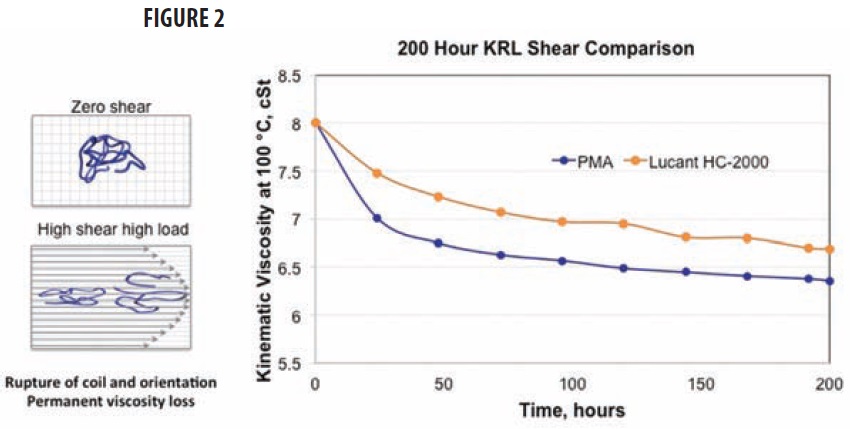
Bench tests indicate that the fluid thickened by Lucant is expected to improve efficiency and is confirmed in the total hydraulic system efficiency rig.
Total Hydraulic System Efficiency Testing
Lubrizol developed a proprietary test rig, modeled after a real-life mobile hydraulic equipment with a hydrostatic drive system, which can measure the efficiency of the whole system with precision and accuracy. Fitted with pressure transducers, temperature sensors and flow meters, the rig can give information beyond efficiency measurement in a pump.
A typical hydraulic system consists of one or more pumps, motors, valves, filters, heat exchangers and hoses. As the hydraulic fluid passes through each of the components, it loses some energy via heat dissipation and other modes. While the pump efficiency consists of only volumetric (η
v) and mechanical efficiency (η
m), total hydraulic system efficiency is complex and combines volumetric (η
vc) and mechanical (η
mc) efficiency of both the pump and motor and operational efficiency (η
o) which encompasses losses occurring in hoses, filters and other components. Pump efficiency is only a partial contributor of the total system efficiency.
Pump efficiency (ηp) = ηv x ηm
Total System efficiency (ηs) = ηvc x ηmc x ηo
Three fluids, all in ISO VG 46, were selected for this test:
•
A monograde reference fluid formulated in Group I base oil
•
A commercial fluid
•
A candidate-formulated Lucant HC-2000 viscosity modifier in Group III base oil with energy efficient additive package
The plots below (
Figure 3) indicate that the commercial fluid formulated with poly(alkylmethacrylate) (PMA) looks better than Lubrizol’s energy efficient candidate in the pump efficiency. However, the order is reversed with pronounced differentiation in the total system efficiency plot. These two plots show that pump efficiency data by itself can be misleading.
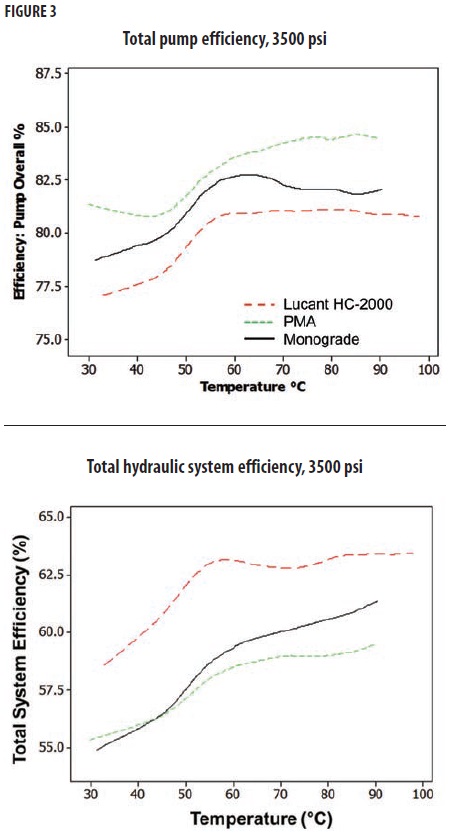
These results emphasize the importance of running the total system efficiency test as opposed to just the pump efficiency test.
Whole Vehicle Testing
The vehicle selected for this work was a used backhoe loader fitted with a C4.4 engine and a standard transmission. It was fitted with pressure transducers, temperature sensors, speed sensors and flow meters. Ancillary devices attached to the engine such as the cooling system were maintained in a steady state of operation. A professional operator was hired to run the backhoe following a constant duty cycle. To avoid inconsistencies, the hydraulic system was loaded with fixed weights of known mass.
A monograde hydraulic fluid was chosen as the reference and was run before and after each candidate fluid. The first candidate was formulated with a shear stable PMA viscosity modifier in Group II base oil to provide a high viscosity index fluid. The second and third candidates were formulated with Lucant HC-2000 shear stable viscosity modifier in Group II and III base oils, respectively. All candidates were formulated to ISO 46 with the same additive.
The data was collected, analyzed and statistically corrected for environmental factors which generated a 3-dimensional map of brake specific fuel consumption, hydraulic flow and power. A percentage benefit map was generated by cross-comparison of the reference map with that of each candidate. This indicates the increase or decrease in the specific fuel consumption for a given candidate compared to the reference fluid.
For each duty cycle, the raw data was analyzed to understand the time weighted average conditions of the hydraulic system for a given task. This was used to calculate an efficiency value from the difference maps that represents a fair and accurate assessment based on actual operating conditions and duty cycles. In each case, fluid formulated with Lucant HC-2000 proved to have a significantly higher hydraulic efficiency than the corresponding monograde and PMA containing multigrade fluids, which failed to provide evidence of improved hydraulic efficiency compared to the monograde reference fluid.
This data (shown in
Figure 4) suggests an operator currently using a monograde hydraulic fluid will benefit from a 3 - 6% improvement in specific fuel consumption by upgrading to a Lucant HC-2000 containing multigrade hydraulic fluid. Efficiency gains will vary depending on equipment, the environment and duty cycle.
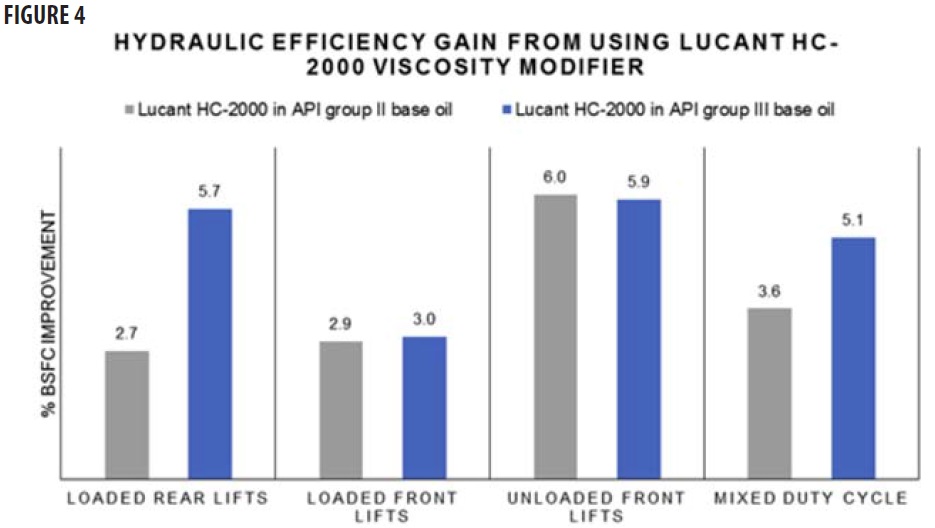 Field Evaluation
Field Evaluation
Lubrizol collaborated with a local construction company to evaluate the candidate with Lucant HC-2000 against commercial fluids in a real-life equipment operating in the field to determine if fuel savings would be realized when using an energy-efficient hydraulic fluid. The trial was conducted over a 3-month period using a wheel loader.
Three fluids were tested: a monograde ISO VG 46, a test fluid with Lucant HC-2000 in API Group II base oil and the standard 10W-30 shop oil used by the test site. Fuel usage was monitored with manual and automated logs, both of which tracked closely.
Considering the importance of duty cycles, the results from the trial was broadly classified into three duty cylces – traversing, idling and loaded – which can be correlated to different vehicle and engine speeds. High vehicle speed corresponds to the vehicle traversing, low vehicle along with low engine speed corresponds to idling conditions and low vehicle speed coupled with high engine speed corresponds to loaded conditions.
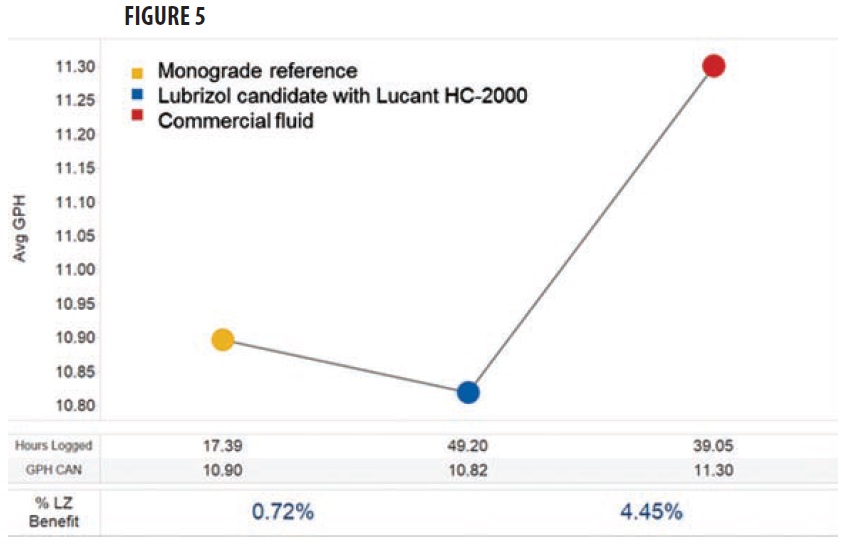
Average fuel consumption in gallons per hour (GPH) was plotted for the three fluids. The candidate with Lucant HC-2000 was observed to consume lowest average fuel compared to the other two fluids. On further analysis, it was noticed that, during the trial period, the fuel changed from summer grade to winter grade. The results were normalized considering the fuel change during the trial and the Lucant based formula showed fuel savings over the other two fluids even with changeover. From the field trial, it can be concluded that candidate fluid formulated with Lucant HC-2000 in Group II base oil reduces fuel consumption.
This concludes the four step validation with bench test, total hydraulic system efficiency rig, whole vehicle test, and field evaluation; all of which confirmed efficiency improvement observed when formulated with Lucant HC-2000.
Industrial Gear Efficiency
Lubrizol has also developed a two-step testing protocol to develop an energy efficient industrial gear lubricant. While the bench tests are widely used in the industry, Lubrizol developed a proprietary worm gearbox efficiency test to screen candidates and formulate energy efficient industrial gear oils.
Industrial gear oils formulated with Lucant HC-2000 and IG93MA show lower traction coefficient, higher energy efficiency and lower operating temperature in statistically validated tests.
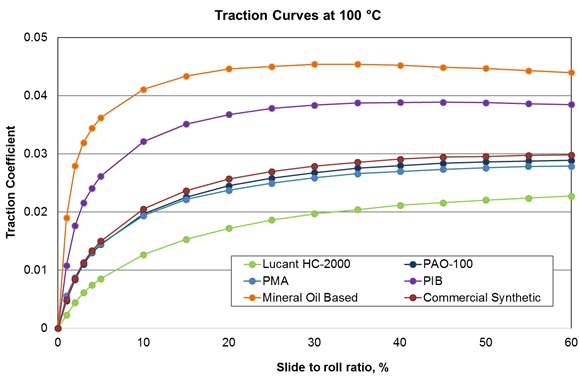

In conclusion, Lubrizol is committed to develop technology that will enable our customers achieve both energy efficiency and durability for both hydraulic and industrial gear oils. Lubrizol’s performance polymer, Lucant HC-2000, helps extract energy efficiency for industrial fluids while reducing traction coefficient and operating temperature.